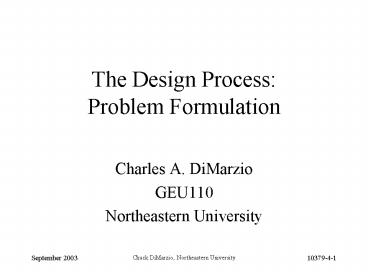The Design Process: Problem Formulation PowerPoint PPT Presentation
Title: The Design Process: Problem Formulation
1
The Design Process Problem Formulation
- Charles A. DiMarzio
- GEU110
- Northeastern University
2
The Design Process
- Remember these phases are not absolute
- The edges are rough
- We often use multiple loops
- Usually we dont think about the process at all
- Its best taught by examples
3
What is the Real Problem?
- Constraints and Boundaries (quantitative)
- Maximum size hole in aircraft for Lidar
- Qualitative Goals (more or less)
- Restate Goal, Change Emphasis
- Input/Output Analysis
- ???
4
Revision Method
- Method
- Start with something that works,
- Build it,
- Refine it through evolutionary design.
- Advantages
- Working design in short time
- It just might be good enough
- It points out the approach to making it better
- Example
- Mohs Surgery
5
Duncker Diagram
System Level Problems Environment, Transportation
Present State
Desired State
General Solutions
Functional Solutions
Specific Solutions
6
Kepner-Tregoe Situation Analysis
Timing (urgency)
Trend (growth)
Impact (consequences)
7
Kepner-Tregoe Problem Analysis
What Is?
What Is Not?
Cause of Distinction
Distinction
Identity
Location
Timing
Magnitude
8
Kepner-Tregoe Problem Analysis
What is?
What is not?
Distinction?
Possible Cause?
Coming Later K-T Decision Analysis
(Quantitative)
9
What is the Value of These Methods?
- Thinking (Alone)
- Brainstorming (Together)
- Justifying (to whom?)
Think about formal vs. Informal use of these
Methods.
10
An Example
- Severe Storms Lidar Scanner to produce a stable
scan pattern from an aircraft with roll, pitch
(and heading?). - 13 hole in airplane
- Airworthyness issues for outside structures
- Cost, speed (1/4 sec), etc.
11
Example Continued
- Proposal Brainstorming
- Stick Model for Light Beams
- 2 Mirrors, Gimbled Mirror, Flip Mirror
- Outside Structure, Wedge, 2 Wedges
- Abstraction, Synthesis, Analysis for Each
- Implementation only for 2 Wedges
- Then developed more complicated model with
calibration
12
Major Project Guidelines
- What are you proposing?
- One of a kind (eg. Bridge)
- One at a time (eg. femtosecond laser)
- Mass production (eg. Consumer product)
- Prototype (think about design and single-unit
cost) - Production line (think about cost per unit)
13
Some Major Project Issues
- Why is your design needed?
- What problem are you trying to solve?
- Why is your solution best?
- What analysis will you do?
- Who can/will pay the required cost?
- What are the unintended consequences?
- What are the political and social issues?
- What are the environmental issues?
- What expertise do you need on your team?
14
Minor Project
- Grading on
- Report (40)
- Device (40)
- Success (20)
15
A Word About Reports
- I give points for
- Cover Letter (If appropriate)
- Abstract
- Table of Contents and Figures
- Technical Content (Most heavily)
- References (If appropriate)
- Grammar and Spelling
- General Appearance
16
Some Grammar Issues
- A preposition is a terrible part of speech to end
a sentence with. - And starting with a conjunction isnt much
better. - Another thing. Little short phrases. Not quite
sentences. Not good. Unless you are Jonathan
Franzen.
17
Some Style Issues
- Use section headings.
- Informal expressions in technical writing are
usually uncool. - Use parallel constructions in lists.
- Never have one item in a sublist
- Active voice and first person are acceptable to
me, but not to everyone in engineering. - Mistakes were made.
- You shouldnt use the second person.
- Give figures and tables numbers, and refer to
them in the text.
18
Websites as Sources
- Use the web to...
- Learn about a new field
- Find out who is working in the field
- Get pointers to the archival literature
- Do not use web pages as citations
- They are transient
- They are not refereed
- Catalog information for pricing, etc. is an
exception if you include date information, etc.
19
Some Ethical Issues
- If you borrow a figure, cite the source.
- Reference anyone who contributes to your idea.
- Paraphrasing is not the same thing as expressing
your own thoughts.
20
Teams
- 1 Rishi Dhupar, Bryan Mayor, Joe Mayotte
- 2 Matt Bouchard, Brian Carlin, Anne Fitzpatrick
- 3 Eric Blaisdell, David Despres, Mikio
Yanagisawa - 4 Chuba Arah, Marco Solia, Jonathan Palmer
- 5 Shannon Rooney, Jenine Davignon, Kevin Harvey
- 6 Sean O'Blenis, Kelly Chronley, Sammy Shaar
- 7 Graham Turner, Danny MacDougall, Steve Jahnes
- 8 Dan Bastable, Bryan Fors, Kyle Nowak
- 9 Jonathan Correia, Marsel Kane, Khue Nguyen,
Steve Yu - 10 Michael Hart, Mike Santorella, Robert Taylor

